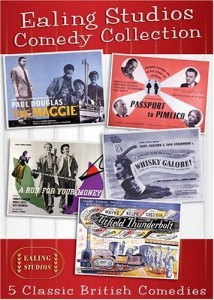The Titfield Thunderbolt ***** (1953, Stanley Holloway, George Relph, Naunton Wayne, John Gregson) – Classic Movie Review 1640
English villagers take direct action when their rail line faces heartless government closure by running it themselves. Charles Crichton’s 1953 Ealing Studios comedy gem The Titfield Thunderbolt glories in the antique values of the old and the quaint.
The feisty, lovable residents of a small English West Country village take direct action when their ancient local rail line faces heartless government closure to rescue it by running it themselves, coming into competition with the bus company. Director Charles Crichton’s glorious 1953 Ealing Studios comedy gem glories decadently but beguilingly in the ancient, antique values of the old and the quaint.
Even in its day it was a gleaming museum exhibit as a celebration of the past, but it had the downside of being on the side of helping to hold back progress in the Fifties when Britain needed to shake itself into a brave new world that finally arrived with the Swinging Sixties. Its liberal, anti-authority values are impeccable, though. Also, speaking out against rail closures that were isolating outlying British areas was certainly a darned good thing. This might have seemed like progress to right-wing politicians but it was progress in the wrong direction. Britain still suffers today as a result of these closures.
Douglas Slocombe’s Technicolor cinematography is beautiful and certainly makes the rolling stock gleam, but it oddly seems a bit redundant with a story, backdrops and cast that seem made to be shot in black and white.
This is exhilarating old-fashioned entertainment from a bygone era. Even if it is essentially conservative and reactionary, it’s very warm hearted and good spirited, as well as being a pro-people movie, and those are the virtues that shine through. In its power-to-the-people sense, the film predicts the Swinging Sixties rather than holding them back.
The Titfield Thunderbolt is quite beautifully played by treasurable performers like Stanley Holloway, George Relph, Naunton Wayne and John Gregson, who have a crisp, clear and intelligent screenplay with good, credible dialogue, and expert direction to support their performances. The conservative political message comes over loud and clear, but it is subtly and appealingly stated in one of T E B Clarke’s most expert and excellent screenplays.
Godfrey Tearle, Hugh Griffith, Sid James [Sidney James], Edie Martin, Gabrielle Brune, Jack MacGowran, Ewan Roberts, Reginald Beckwith, Michael Trubshawe and Wensley Pithey also shine in the cast.
Charles Crichton is the director of Hue and Cry, The Lavender Hill Mob, The Battle of the Sexes and A Fish Called Wanda.
The Titfield Thunderbolt is inspired by the restoration of the narrow gauge Talyllyn Railway in Wales, the world’s first heritage railway run by volunteers. Titfield is a mix of Titsey and Limpsfield, villages in Surrey near T E B Clarke’s home at Oxted. The film is also inspired by the 1953 book Railway Adventure by L T C Rolt. Clarke visited the Talyllyn Railway in 1951 and spent two days learning of the work of its volunteers. Incidents in the film such as the emergency re-supply of water to the locomotive by buckets from an adjacent stream and passengers being asked to help push the carriages happened on the Talyllyn Railway as told in Railway Adventure.
The cast are Stanley Holloway as Walter Valentine, George Relph as Vicar Sam Weech, Naunton Wayne as George Blakeworth, John Gregson as Squire Gordon Chesterford, Godfrey Tearle as Ollie Matthews Bishop of Welchester, Hugh Griffith as Dan Taylor, Gabrielle Brune as Joan Hampton, Sid James [Sidney James] as Harry Hawkins, Reginald Beckwith as Coggett, Edie Martin as Emily, Michael Trubshawe as Ruddock, Jack MacGowran as Vernon Crump, Ewan Roberts as Alec Pearce, Herbert C Walton as Seth, John Rudling as Clegg, Nancy O’Neil as Mrs Blakeworth, Campbell Singer as Police Sergeant, Frank Atkinson as Station Sergeant, and Wensley Pithey as Policeman.
Driver Ted Burbidge, fireman Frank Green and guard Harold Alford were British Railways employees from the Westbury depot hired to operate the locomotives, but Charles Crichton gave them credited speaking roles.
Shooting mostly took place near Bath, Somerset, on the Camerton branch of the Bristol and North Somerset Railway, along the Cam Brook valley between Camerton and Limpley Stoke. The branch closed on 15 February 1951 but reopened for filming. Titfield railway station was Monkton Combe railway station, while Titfield village was nearby Freshford, with other scenes shot at the disused Dunkerton Colliery.
http://derekwinnert.com/passport-to-pimlico-classic-film-review-47/
http://derekwinnert.com/the-lavender-hill-mob-classic-film-review-121/
http://derekwinnert.com/a-fish-called-wanda-classic-film-review-350/
© Derek Winnert 2014 Classic Movie Review 1640
Check out more reviews on http://derekwinnert.com/






